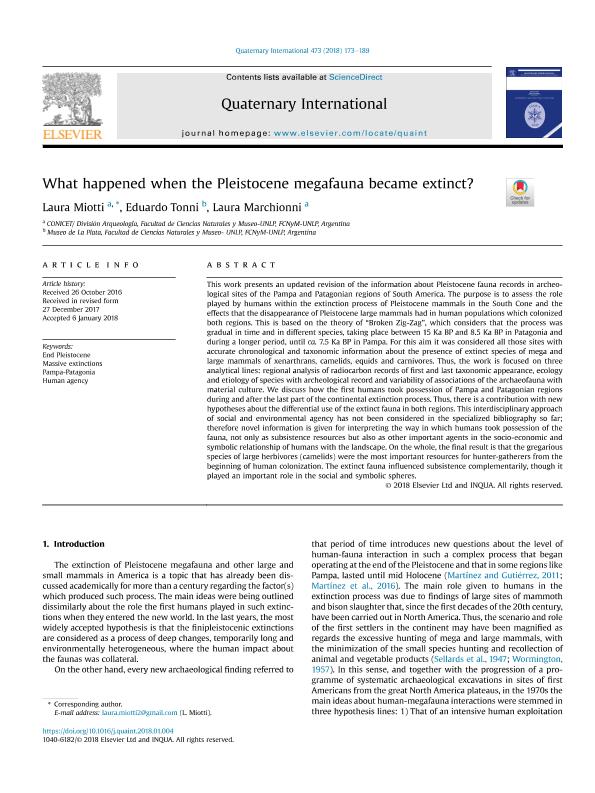Artículo
What happened when the Pleistocene megafauna became extinct?
Fecha de publicación:
04/2018
Editorial:
Pergamon-Elsevier Science Ltd
Revista:
Quaternary International
ISSN:
1040-6182
Idioma:
Inglés
Tipo de recurso:
Artículo publicado
Clasificación temática:
Resumen
This work presents an updated revision of the information about Pleistocene fauna records in archeological sites of the Pampa and Patagonian regions of South America. The purpose is to assess the role played by humans within the extinction process of Pleistocene mammals in the South Cone and the effects that the disappearance of Pleistocene large mammals had in human populations which colonized both regions. This is based on the theory of “Broken Zig-Zag” which considers that the process was gradual in time and in different species, taking place between 15 Ka BP and 8.5 Ka BP in Patagonia and during a longer period, until ca. 7.5 Ka BP in Pampa. For this aim it was considered all those sites with accurate chronological and taxonomic information about the presence of extinct species of mega and large mammals of xenarthrans, camelids, equids and carnivores. Thus, the work is focused on three analytical lines: regional analysis of radiocarbon records of first and last taxonomic appearance, ecology and etiology of species with archeological record and variability of associations of the archaeofauna with material culture. We discuss how the first humans took possession of Pampa and Patagonian regions during and after the last part of the continental extinction process. Thus, there is a contribution with new hypotheses about the differential use of the extinct fauna in both regions. This interdisciplinary approach of social and environmental agency has not been considered in the specialized bibliography so far; therefore novel information is given for interpreting the way in which humans took possession of the fauna, not only as subsistence resources but also as other important agents in the socio-economic and symbolic relationship of humans with the landscape. On the whole, the final result is that the gregarious species of large herbivores (camelids) were the most important resources for hunter-gatherers from the beginning of human colonization. The extinct fauna influenced subsistence complementarily, though it played an important role in the social and symbolic spheres.
Palabras clave:
End Pleistocene
,
Human Agency
,
Massive Extinctions
,
Pampa-Patagonia
Archivos asociados
Licencia
Identificadores
Colecciones
Articulos(CCT - LA PLATA)
Articulos de CTRO.CIENTIFICO TECNOL.CONICET - LA PLATA
Articulos de CTRO.CIENTIFICO TECNOL.CONICET - LA PLATA
Citación
Miotti, Laura Lucia; Tonni, Eduardo Pedro; Marchionni, Laura; What happened when the Pleistocene megafauna became extinct?; Pergamon-Elsevier Science Ltd; Quaternary International; 473; 4-2018; 173-189
Compartir
Altmétricas




